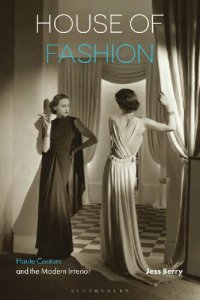
Ebook: House of Fashion: Haute Couture and the Modern Interior
Author: Jess Berry
- Year: 2018
- Publisher: Bloomsbury Visual Arts
- Language: English
- pdf
Since the beginnings of haute couture, when Charles Fredrick Worth established his Maison in 1858, the interior has been an important backdrop to the spectacle of fashion. This book is the first to primarily focus on the significant interplay between fashion and the modern interior at a time when these two professions dedicated to adornment and display were developing.
Focusing particularly on the period from 1860 to the 1960s, this book traces how noteworthy haute-couture designers, including Paul Poiret, Madeleine Vionnet, Elsa Schiaparelli, Coco Chanel, and Christian Dior, leveraged both commercial spaces and domestic interiors in an effort to enhance their artistic identities and publicize their credentials as connoisseurs of style. Further, it sets out the links between these couturiers and modern architects and designers, including Louis Süe, Robert Mallet-Stevens, Eileen Gray, and Jean-Michel Frank among others. It argues that these collaborations cultivated a level of taste and style that enabled the integration of luxurious lifestyles and fashionable dress to form new modern identities for practitioners and their clientele alike.
The book adopts an interdisciplinary approach to the analysis of fashion’s interiors that appeared as photographs, advertisements, paintings, and illustrations. Drawing on critical theory, social history, and gender politics, along with theoretical interpretations of fashion and the interior, it will argue that the salon, the atelier, the boutique, and the home provided a spectacular setting for the performance of fashion that would enhance the couturier’s public image and cultivate an aura of exclusivity for their labels—a system that continues to have resonance for contemporary fashion.
Since Charles Fredrick Worth established his luxurious Maison de Couture in 1858, the interior has played a crucial role in the display of fashion. House of Fashion provides a full historical account of the interplay between fashion and the modern interior, demonstrating how they continue to function as a site for performing modern, gendered identities for designers and their clientele alike. In doing so, it traces how designers including Poiret, Vionnet, Schiaparelli, and Dior used commercial spaces and domestic interiors to enhance their credentials as connoisseurs of taste and style.
Taking us from the early years of haute couture to the luxury fashion of the present day, Berry explores how the salon, the atelier, and the boutique have allowed fashion to move beyond the aesthetics of dress, to embrace the visual seduction of the theatrical, the artistic, and the exotic. From the Art Deco allure of Coco Chanel’s Maison to the luminous spaces of contemporary flagship stores, House of Fashion sets out fashion’s links with key figures in architecture and design, including Louis Süe, Robert Mallet-Stevens, Eileen Gray, and Jean-Michel Frank. Drawing on photographs, advertisements, paintings, and illustrations, this interdisciplinary study examines how fashionable interiors have shaped our understanding of architecture, dress, and elegance.
Focusing particularly on the period from 1860 to the 1960s, this book traces how noteworthy haute-couture designers, including Paul Poiret, Madeleine Vionnet, Elsa Schiaparelli, Coco Chanel, and Christian Dior, leveraged both commercial spaces and domestic interiors in an effort to enhance their artistic identities and publicize their credentials as connoisseurs of style. Further, it sets out the links between these couturiers and modern architects and designers, including Louis Süe, Robert Mallet-Stevens, Eileen Gray, and Jean-Michel Frank among others. It argues that these collaborations cultivated a level of taste and style that enabled the integration of luxurious lifestyles and fashionable dress to form new modern identities for practitioners and their clientele alike.
The book adopts an interdisciplinary approach to the analysis of fashion’s interiors that appeared as photographs, advertisements, paintings, and illustrations. Drawing on critical theory, social history, and gender politics, along with theoretical interpretations of fashion and the interior, it will argue that the salon, the atelier, the boutique, and the home provided a spectacular setting for the performance of fashion that would enhance the couturier’s public image and cultivate an aura of exclusivity for their labels—a system that continues to have resonance for contemporary fashion.
Since Charles Fredrick Worth established his luxurious Maison de Couture in 1858, the interior has played a crucial role in the display of fashion. House of Fashion provides a full historical account of the interplay between fashion and the modern interior, demonstrating how they continue to function as a site for performing modern, gendered identities for designers and their clientele alike. In doing so, it traces how designers including Poiret, Vionnet, Schiaparelli, and Dior used commercial spaces and domestic interiors to enhance their credentials as connoisseurs of taste and style.
Taking us from the early years of haute couture to the luxury fashion of the present day, Berry explores how the salon, the atelier, and the boutique have allowed fashion to move beyond the aesthetics of dress, to embrace the visual seduction of the theatrical, the artistic, and the exotic. From the Art Deco allure of Coco Chanel’s Maison to the luminous spaces of contemporary flagship stores, House of Fashion sets out fashion’s links with key figures in architecture and design, including Louis Süe, Robert Mallet-Stevens, Eileen Gray, and Jean-Michel Frank. Drawing on photographs, advertisements, paintings, and illustrations, this interdisciplinary study examines how fashionable interiors have shaped our understanding of architecture, dress, and elegance.
Download the book House of Fashion: Haute Couture and the Modern Interior for free or read online
Continue reading on any device:

Last viewed books
Related books
{related-news}
Comments (0)